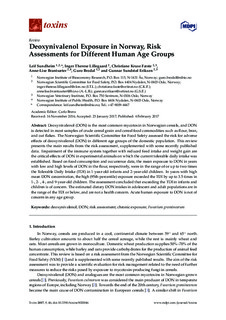Deoxynivalenol Exposure in Norway, Risk Assessments for Different Human Age Groups
Sundheim, Leif; Lillegaard, Inger Therese L.; Fæste, Christiane Kruse; Brantsæter, Anne Lise; Brodal, Guro; Eriksen, Gunnar Sundstøl
Peer reviewed, Journal article
Published version

Date
2017Metadata
Show full item recordCollections
- Artikler [5061]
- Publikasjoner fra CRIStin FHI [7536]
Abstract
Deoxynivalenol (DON) is the most common mycotoxin in Norwegian cereals, and DON is detected in most samples of crude cereal grain and cereal food commodities such as flour, bran, and oat flakes. The Norwegian Scientific Committee for Food Safety assessed the risk for adverse effects of deoxynivalenol (DON) in different age groups of the domestic population. This review presents the main results from the risk assessment, supplemented with some recently published data. Impairment of the immune system together with reduced feed intake and weight gain are the critical effects of DON in experimental animals on which the current tolerable daily intake was established. Based on food consumption and occurrence data, the mean exposure to DON in years with low and high levels of DON in the flour, respectively, were in the range of or up to two times the Tolerable Daily Intake (TDI) in 1-year-old infants and 2-year-old children. In years with high mean DON concentration, the high (95th-percentile) exposure exceeded the TDI by up to 3.5 times in 1-, 2- , 4-, and 9-year-old children. The assessment concluded that exceeding the TDI in infants and children is of concern. The estimated dietary DON intakes in adolescent and adult populations are in the range of the TDI or below, and are not a health concern. Acute human exposure to DON is not of concern in any age group.